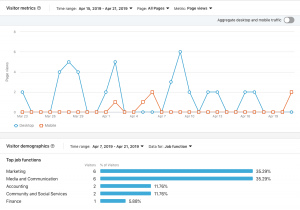Digital PR is now an intrinsic part of any PR and media relations campaign, but how can you measure its success and engagement with your target audiences? The V Formation PR team highlights some of the metrics and tools that can help you measure the impact of your digital PR.
 Digital PR is used to increase a brand’s online visibility and reach. It helps you reach your target audience by featuring your content on the websites and social media feeds that they view. Effective digital PR can drive new traffic to your website, improve your SEO ranking and deliver quality backlinks to your website.
Digital PR is used to increase a brand’s online visibility and reach. It helps you reach your target audience by featuring your content on the websites and social media feeds that they view. Effective digital PR can drive new traffic to your website, improve your SEO ranking and deliver quality backlinks to your website.
Measuring digital PR helps you see precisely the elements of your plan that are working – and those that need tweaking. It delivers invaluable insights to enable you to adjust and improve the campaign tactics as you go for the best possible results. The availability of online tools means it is often easier to track and measure than traditional PR.
Ultimately, the outputs of any digital PR activity should always be measured against your agreed PR objectives, as set out in your PR strategy.
So, to deliver a quantifiable return on investment for digital PR, what are some of the key metrics you should be looking for?
Impressions
An impression could be anything from the number of encounters with content on social media, to the average number of readers of an online magazine where a news article has been published. Looking at whether the volume of impressions has risen is a useful basis for identifying if your digital PR strategy has been a success.
CoverageBook, an easy-to-use PR tool that compiles and displays media coverage, provides you with an estimated number of monthly views that a website receives (powered by SimilarWeb), and an estimated number of views that coverage will receive in its lifetime.
While this is a great starting point, what impressions fail to provide is any actionable information. To measure true success, you’ll need to delve a bit deeper into engagement numbers. A great place to start is social media….
Social media engagement
Social media is a really effective way of seeing how well your content is being engaged with and received. Are people enjoying a new blog post? Is your news story getting a good response? A look at the number of visible engagement actions on social media platforms – followers, likes, clicks, comments and shares – builds a picture of how well a piece of content is performing.
Some popular platforms offer inbuilt tools that provide a more thorough round-up of social media engagement numbers.

A good example is Facebook Insights, which shows how reach, followers, page views and actions-on-page numbers have fluctuated over a period of time on Facebook. Taking note of these figures both before and after PR contributes to building a picture of its success, or where changes may need to be made. Twitter and LinkedIn also have their own analytics tools.
Other tools such as Hootsuite or Sprout Social can help to monitor campaigns, boost engagement and build a social media report.
Website traffic
Digital PR can be hugely influential in driving traffic to your website, perhaps most obviously through earned media mentions. ‘Earned media’ is publicity that has been organically acquired through promotional efforts rather than through paid media advertising.
Google Analytics is a widely used and free tool that can help you identify where your website traffic comes from. You can get tons of data from Google Analytics, but looking at referral traffic is a valuable way of measuring how successful PR has been. There should be a spike in numbers following coverage of press releases, guest blogs, or any other earned media gained through PR efforts.
Quality backlinks
Good PR professionals will do their utmost to include backlinks in all content, as these are especially good for boosting search engine rankings. When backlinks to your website are secured from sites with a high domain authority, they will not only increase your ranking on Google and other platforms, but also the quality of traffic heading your way.
You can monitor where backlinks are coming from using platforms such as Buzzsumo and Moz. ‘Bad backlinks’, like those placed on websites with no relevance to your company or brand, or those with a low domain authority, can result in your website’s ranking suffering too, so it really is useful to keep track of your traffic.
These are just a handful of tools you can use to help you measure the impact of your digital PR.
To discuss how V Formation’s expert PR consultants can help you create an effective PR strategy and improve your communications, please call us on 0115 667 0131 or contact us here.





